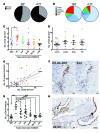Cyclooxygenase-2-dependent lymphangiogenesis promotes nodal metastasis of postpartum breast cancer
- PMID: 25133426
- PMCID: PMC4153700
- DOI: 10.1172/JCI73777
Cyclooxygenase-2-dependent lymphangiogenesis promotes nodal metastasis of postpartum breast cancer
Abstract
Breast involution following pregnancy has been implicated in the high rates of metastasis observed in postpartum breast cancers; however, it is not clear how this remodeling process promotes metastasis. Here, we demonstrate that human postpartum breast cancers have increased peritumor lymphatic vessel density that correlates with increased frequency of lymph node metastases. Moreover, lymphatic vessel density was increased in normal postpartum breast tissue compared with tissue from nulliparous women. In rodents, mammary lymphangiogenesis was upregulated during weaning-induced mammary gland involution. Furthermore, breast cancer cells exposed to the involuting mammary microenvironment acquired prolymphangiogenic properties that contributed to peritumor lymphatic expansion, tumor size, invasion, and distant metastases. Finally, in rodent models of postpartum breast cancer, cyclooxygenase-2 (COX-2) inhibition during the involution window decreased normal mammary gland lymphangiogenesis, mammary tumor-associated lymphangiogenesis, tumor cell invasion into lymphatics, and metastasis. Our data indicate that physiologic COX-2-dependent lymphangiogenesis occurs in the postpartum mammary gland and suggest that tumors within this mammary microenvironment acquire enhanced prolymphangiogenic activity. Further, our results suggest that the prolymphangiogenic microenvironment of the postpartum mammary gland has potential as a target to inhibit metastasis and suggest that further study of the therapeutic efficacy of COX-2 inhibitors in postpartum breast cancer is warranted.
Figures





Comment in
-
Inflammatory lymphangiogenesis in postpartum breast tissue remodeling.J Clin Invest. 2014 Sep;124(9):3704-7. doi: 10.1172/JCI77765. Epub 2014 Aug 18. J Clin Invest. 2014. PMID: 25133423 Free PMC article.
References
Publication types
MeSH terms
Substances
Grants and funding
LinkOut - more resources
Full Text Sources
Other Literature Sources
Medical
Research Materials

